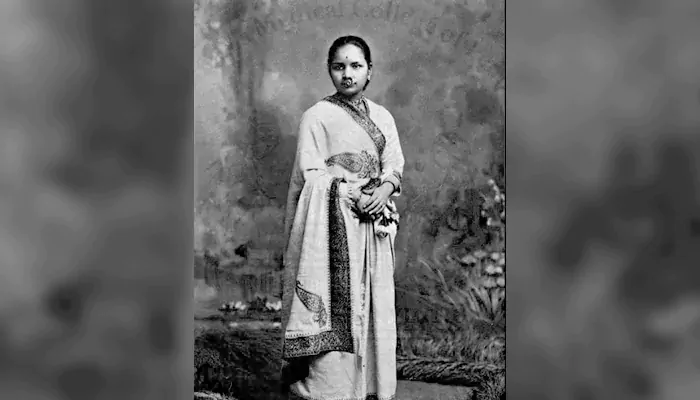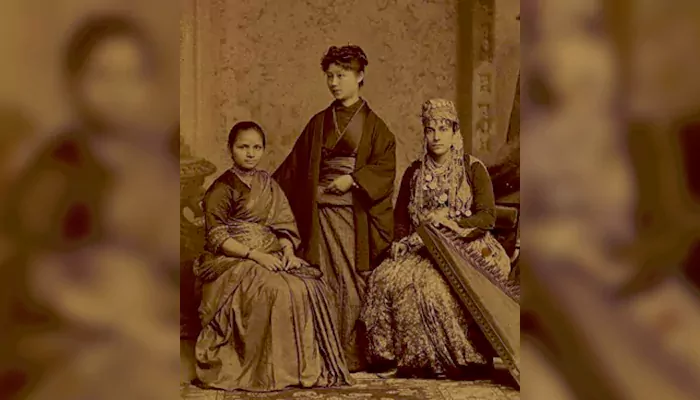
She was the first Indian woman to practice Western medicine, along with Kadambini Ganguly.
It’s 2025, and even today, a woman from an average middle-class Indian family has to fight harder than a man to pursue higher studies, especially in fields like medicine. Now, rewind to the 1800s, when there was no female doctor as a role model. It was a society bound by strict norms and a belief that a woman’s world ended at her doorstep.
In that world, a young girl named Anandi dared to dream of becoming a doctor. She set out to study medicine in the West and return to serve Indian women who had no access to female physicians. Alongside Kadambini Ganguly, she holds the honor of being India’s first female doctor of Western medicine.
Born this day in 1865: Anandi Gopal Joshi, India's first female doctor. https://t.co/DwXZAIP8ZQ pic.twitter.com/KYetktxor7
— Wikipedia (@Wikipedia) March 31, 2017
(Credit: Wikipedia)
But Anandi wasn’t just a doctor. She was a rebel as well, challenging customs, critics, and even her own body to leave behind a legacy that still inspires.
Imagine a nine-year-old girl, married to a man two decades older, with her life already decided for her. That was Yamuna’s (Anandi's birth name) fate in 1874 when she was married to Gopalrao Joshi, a postal clerk with unconventional ideas. Her family, once prosperous Brahmins, had been brought to their knees by British taxation, and marriage was seen as their only way out.
Yet she wasn’t the kind to accept silence as destiny. Gopalrao, despite his many contradictions, recognized her intellect and encouraged her to study. He renamed her Anandi, and under his guidance, she learned to read and write in multiple languages. She once vowed, “I will go as a Hindu and return as one,” clinging firmly to her identity even as she set out to challenge everything that tradition prescribed.
At 14, Anandi gave birth to a son who died just ten days later, an unbearable loss that would change the course of her life. With no female doctors available and cultural restrictions preventing many women from seeking help from male physicians, her baby had no real chance. That grief gave birth to a mission. “I must become a doctor,” she promised herself, to ensure other women didn’t suffer the way she had.
In 1883, at just 18, Anandi stood before a packed hall at Serampore College near Calcutta and delivered a speech in English, a language she had only recently mastered. Draped in a saree, she made a radical case: she wanted to travel to America to study medicine.
“There is a growing need for Hindu lady doctors in India, and I volunteer to qualify myself for one,” she said, challenging not only gender roles but colonial expectations. At a time when public speaking by women (especially in English) was virtually unheard of, her words emerged as revolutionary.
Anandi Gopal Joshi: The First Indian Woman Doctor
— Medical Heritage Times (@heritagemedical) May 26, 2025
In her biography, Caroline Healey highlights Anandi's achievements, noting that she graduated from the Woman's Medical College of Pennsylvania on March 11, 1886, becoming the first Hindu woman to earn a medical degree worldwide.… pic.twitter.com/5PhPLoDt4J
(Credit: Medical Heritage Times)
As Meera Kosambi observed, Anandi wasn’t simply asking to be allowed to study medicine. She was holding up a mirror to a society that had failed its women. Her speech carried the weight of personal tragedy and the hope of a better future.
Setting sail for America as a young, unmarried Hindu woman was scandalous. In the eyes of orthodox society, crossing the seas meant losing caste, committing a spiritual transgression. Gopalrao’s decision to send her abroad was ridiculed, and the couple was socially ostracized. Some neighbors even hurled cow dung at their home to “purify” it.
But Anandi didn’t flinch. With the support of Theodicia Carpenter, a sympathetic American woman who offered her lodging in New Jersey, she left Calcutta in 1883 and arrived in New York alone. For Anandi, it was a declaration of independence.

She enrolled at the Woman’s Medical College of Pennsylvania, the first medical school for women in the world. Her decision wasn’t just about becoming a doctor, but also about proving that no amount of dogma, distance, or disdain could hold a woman back if she had purpose.
Well, life in America was far from easy. The freezing East Coast winters were brutal on her health, and the food often clashed with her vegetarian lifestyle. But Anandi stayed true to herself. She wore her sarees, kept her bindi and kajal, and refused to shed her identity to fit in.
She studied alongside pioneers like Kei Okami from Japan and Sabat Islambooly from Syria, forming part of an extraordinary global sisterhood in medicine. Her thesis, which explored the connections between Ayurvedic and Western medicine, showed her ability to bridge traditional wisdom and modern science. When she earned her MD in 1886, the college president described the day as one “to be remembered in golden letters.” Even Queen Victoria sent her a congratulatory note, a rare and powerful recognition from a global empire to a young Indian woman.
Every girl’s doctor dream began with her. 🌟
— ICCPL Foundation (@Iccplfoundation) July 5, 2025
This #DoctorsWeek, we honour Dr. Anandi Gopal Joshi—India’s first female doctor and a true trailblazer.
From her courage, thousands of women in medicine draw strength today. 💙🩺#WomenInMedicine #FromHERWeHeal pic.twitter.com/moFMmq8JNM
(Credit: ICCPL Foundation)
Gopalrao Joshi remains one of the more complicated figures in Anandi’s story. He was her earliest champion, encouraging her education and pushing her to think beyond the confines of home. But he was also deeply flawed. Accounts describe him as controlling and at times abusive, demanding that Anandi put studies above everything else, even housework.
Yet, by the time of her death, Anandi had grown far beyond his shadow. “She had outstripped her husband in integrity,” historian Dilip Kumar Chanda wrote. She became more than the woman Gopalrao had envisioned; she became her own person.
Born on 31 March, 1865, Anandi Gopal Joshi of Bombay Presidency, is known as one of the first female doctors of India.
— Indian Culture Portal (@_IndianCulture) August 29, 2024
Discover more on the Indian Culture Portal.#AnandiGopalJoshi #firstfemaledoctorofindia #Anandibai #anandibaijoshi #indianhistory #historytrivia #history pic.twitter.com/dJjMyqEhB8
(Credit: Indian Culture Portal)
What set Anandi apart was that her defiance wasn’t born out of anger, but empathy. And that's why her rebellion was purposeful. She wasn’t trying to break the system just for the sake of it; she wanted to rebuild it for women like her who had no access to healthcare or dignity.
In her 1883 speech, she noted, “Midwifery was not sufficient in any case of medical emergency,” pointing out the limitations placed on women in the name of tradition. Her ambition to open a medical college for women in India remained unfulfilled, as tuberculosis claimed her life in 1887, just a month before she turned 22.
You share your birthday with... India's first female physician... Anandi Gopal Joshi pic.twitter.com/Axtx7tNOzK
— The Times Of India (@timesofindia) March 31, 2021
(Credit: The Times Of India)
Her ashes were interred in Poughkeepsie, New York.
Anandi Gopal Joshi proved that women could lead and transform society. She lived feminism before India even had the word for it. And her name lives on through the Anandibai Joshi Award for Medicine, a commemorative Indian postage stamp issued in 1962, and countless young women who draw strength from her story.